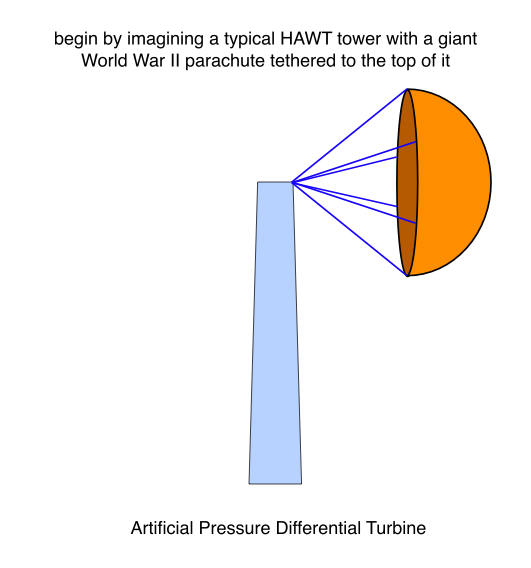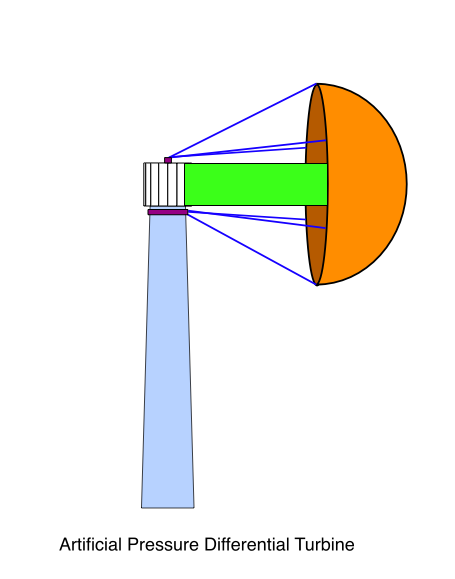

In this way we have brought the low pressure on the downwind side of the parachute to the top of the tower.
Now, in your mind’s eye, eliminate the low pressure tube, and make the parachute whole again. Now attach a high pressure tube to the vertex of the parachute:

Now we have techniques for bringing the high pressure of the upwind side of the parachute back to the tower, and for bringing the low pressure of the downwind side of the parachute back to the tower. Next, we build both the high pressure and low pressure extending tubes into the parachute at the same time. The low pressure tube has the smaller diameter, and it connects to the hole in the vertex of the parachute which has the same diameter. The diameter of the high pressure tube is larger than the diameter of the low pressure tube, and it encircles the low pressure tube so that a cross-section of the two tubes makes them look like concentric circles.
The next step is to transmit the high and low pressures to the bottom of the tower using the same technique. The tower is actually two towers – an inner smaller diameter low pressure tube with an outer larger diameter high pressure tube surrounding it so that a cross-section of the two makes them look like concentric circles. The high pressure and low pressure regions are connected at the bottom of the tower and, as expected, a HAWT rotor (with a vertical axis) is positioned between the two. The rotor, gearbox, and generator are at all at ground level.
The only thing I haven’t explained is how the low pressure and high pressure tubes make a right angle turn at the top of the tower. I was planning to draw some pictures of this, but I don’t think it’s really necessary. There are probably a million ways to do this. I will just note here that the parachute part automatically seeks the downwind position, and so it doesn’t require a yaw system. The right angle joint can be yawed, or it can simply be a cylindrical piece with vents positioned radially about its center. The vents have doors in them that can open and close to simulate yawing, though few moving parts would actually be required. (To illustrate, imagine an aerial view of this machine. Suppose the high and low pressure tubes approach the tower near the 9 o’clock position. Then the vents in the cylindrical piece at the top of the tower that are at positions 8 o’clock, 8:30, 9:00, 9:30, and 10 o’clock would all be open, while all of the other vents would be closed tight and aerodynamically sealed.)
The tower supports little weight, and it can be fitted with vents to let storm winds pass through unimpeded. This means the tower can be very light in weight, very inexpensive (relative to a typical HAWT tower), and it can have a large diameter if necessary. The parachute and the fabric part of the low pressure and high pressure tubes may have similar vents so that they also create little drag during storm winds. Maybe the parachute and fabric vents could even be somehow rolled up and stored inside the tower during storm winds.
Finally, note that the tower could be incredibly high. This is true because it supports little weight, has little overturning moment in storm winds, and can accomodate multi-level guy wires that can attach to the tower at any elevation, including at the very top of the tower!

Yawing Variation
Now we might imagine a long horizontal tube extending from the top of the tower. The supporting cords that tether the parachute are attached to the end of the horizontal tube that is far from the top of the tower. This way, the “vertex” (downwindmost end) of the parachute is right at the top of the tower, and the low and high pressure regions may easily be connected to the vertical (tower) low and high pressure concentric tubes. The horizontal tube yaws to align with the wind.
There are many other variations like this. Maybe we just build something that looks like a giant radio telescope dish, and attach its vertex to the top of the tower. This might not be so ridiculous if the parabolic dish has slats that automatically open when the pressure differential between the upwind and downwind sides of the slats exceeds a safe value.
Leave a comment